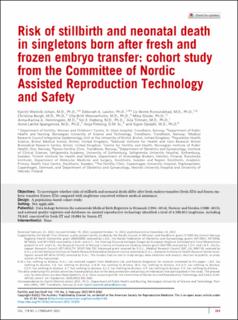| dc.contributor.author | Westvik-Johari, Kjersti | |
| dc.contributor.author | Lawlor, Deborah | |
| dc.contributor.author | Romundstad, Liv Bente Bergem | |
| dc.contributor.author | Bergh, Christina | |
| dc.contributor.author | Wennerholm, Ulla-Britt | |
| dc.contributor.author | Gissler, Mika | |
| dc.contributor.author | Henningsen, Anna-Karina Aaris | |
| dc.contributor.author | Håberg, Siri Eldevik | |
| dc.contributor.author | Tiitinen, Aila | |
| dc.contributor.author | Spangmose, Anne Lærke | |
| dc.contributor.author | Pinborg, Anja Bisgaard | |
| dc.contributor.author | Opdahl, Signe | |
| dc.date.accessioned | 2023-02-22T09:49:52Z | |
| dc.date.available | 2023-02-22T09:49:52Z | |
| dc.date.created | 2023-01-19T12:55:02Z | |
| dc.date.issued | 2022 | |
| dc.identifier.citation | Fertility and Sterility. 2022, 119 (2), 265-276. | en_US |
| dc.identifier.issn | 0015-0282 | |
| dc.identifier.uri | https://hdl.handle.net/11250/3053094 | |
| dc.description.abstract | Main Outcome Measure(s)
Stillbirth (fetal death before and during delivery) and neonatal death (live born with death 0–27 days postpartum).
Result(s)
Overall, 17,123 (0.37%) singletons were stillborn and 7,685 (0.17%) died neonatally. Compared with singletons conceived without medical assistance, the odds of stillbirth were similar after fresh-ET and frozen-ET, whereas the odds of neonatal death were high after fresh-ET (odds ratio [OR], 1.69; 95% confidence interval [CI], 1.46–1.95) and frozen-ET (OR, 1.51; 95% CI, 1.08–2.10).
Preterm birth (<37 gestational weeks) was more common after fresh-ET (8.0%) and frozen-ET (6.6%) compared with singletons conceived without medical assistance (5.0%), and strongly associated with neonatal mortality across all conception methods. Within gestational age categories, risk of stillbirth and neonatal death was similar for all conception methods, except that singletons from fresh-ET had a higher risk of stillbirth during gestational week 22–27 (OR, 1.85; 95% CI, 1.51–2.26).
Conclusion(s)
Overall, the risk of stillbirth was similar after fresh-ET and frozen-ET compared with singletons conceived without medical assistance, whereas neonatal mortality was high, possibly mediated by the high risk of preterm birth when compared with singletons conceived without medical assistance. Our results gave no clear support for choosing one treatment over the other. | en_US |
| dc.language.iso | eng | en_US |
| dc.publisher | Elsevier | en_US |
| dc.rights | Navngivelse 4.0 Internasjonal | * |
| dc.rights.uri | http://creativecommons.org/licenses/by/4.0/deed.no | * |
| dc.title | Risk of stillbirth and neonatal death in singletons born after fresh and frozen embryo transfer: cohort study from the Committee of Nordic Assisted Reproduction Technology and Safety | en_US |
| dc.title.alternative | Risk of stillbirth and neonatal death in singletons born after fresh and frozen embryo transfer: cohort study from the Committee of Nordic Assisted Reproduction Technology and Safety | en_US |
| dc.type | Peer reviewed | en_US |
| dc.type | Journal article | en_US |
| dc.description.version | publishedVersion | en_US |
| dc.source.pagenumber | 265-276 | en_US |
| dc.source.volume | 119 | en_US |
| dc.source.journal | Fertility and Sterility | en_US |
| dc.source.issue | 2 | en_US |
| dc.identifier.doi | 10.1016/j.fertnstert.2022.10.020 | |
| dc.identifier.cristin | 2110324 | |
| cristin.ispublished | true | |
| cristin.fulltext | original | |
| cristin.qualitycode | 2 | |

